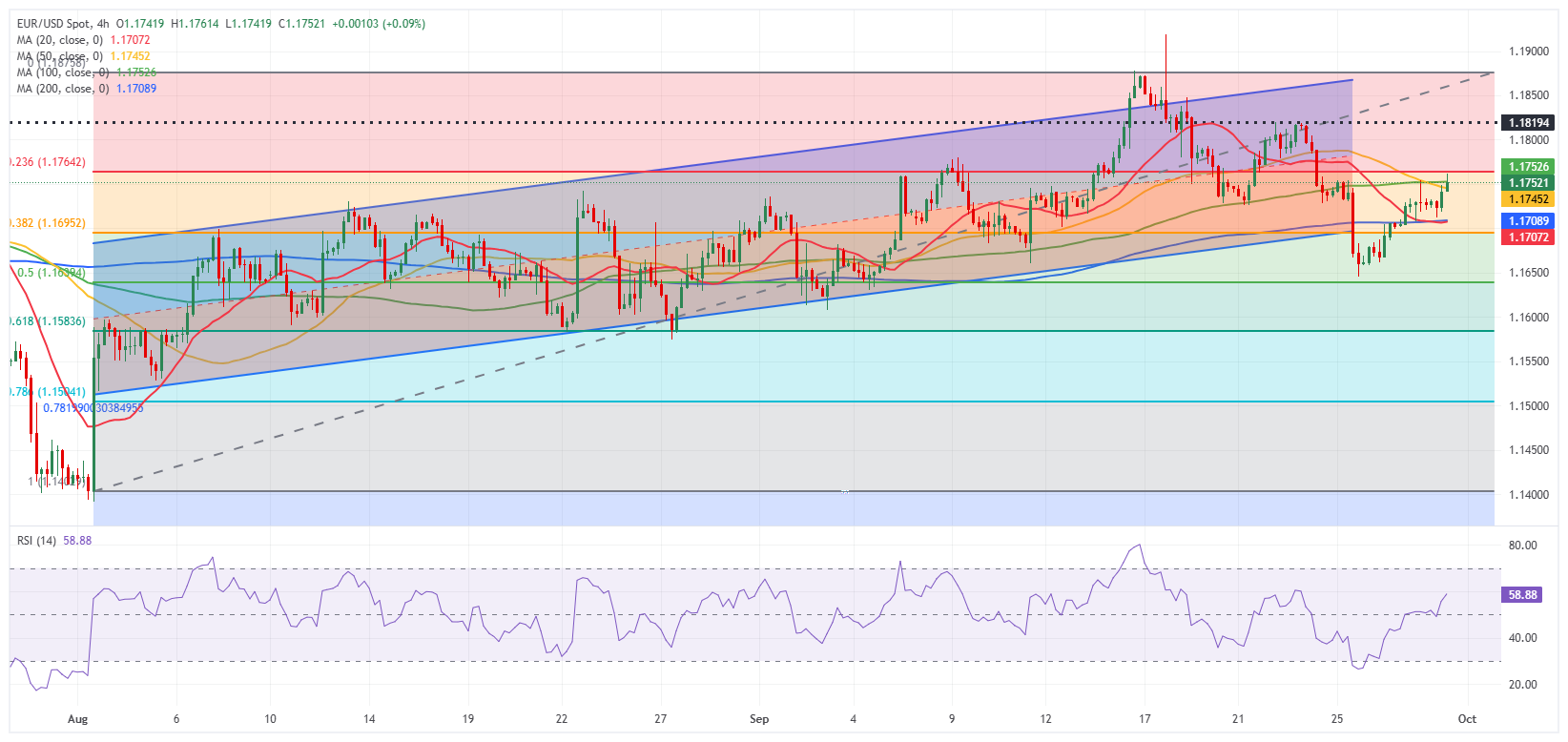- EUR/USD trades in positive territory near 1.1750 early Tuesday.
- A potential government shutdown in the US weighs on the USD.
- The US economic calendar will feature mid-tier macroeconomic data releases.
EUR/USD holds its ground after posting modest gains on Monday and trades in positive territory near 1.1750 on Tuesday, as the US Dollar (USD) struggles to shake off the bearish pressure. Investors will continue to scrutinize political developments in the US.
Euro Price This week
The table below shows the percentage change of Euro (EUR) against listed major currencies this week. Euro was the strongest against the US Dollar.
| USD | EUR | GBP | JPY | CAD | AUD | NZD | CHF | |
|---|---|---|---|---|---|---|---|---|
| USD | -0.39% | -0.35% | -1.06% | -0.16% | -0.86% | -0.10% | -0.10% | |
| EUR | 0.39% | 0.04% | -0.82% | 0.22% | -0.47% | 0.25% | 0.28% | |
| GBP | 0.35% | -0.04% | -0.74% | 0.18% | -0.57% | 0.24% | 0.24% | |
| JPY | 1.06% | 0.82% | 0.74% | 0.92% | 0.22% | 0.82% | 0.99% | |
| CAD | 0.16% | -0.22% | -0.18% | -0.92% | -0.66% | 0.06% | 0.05% | |
| AUD | 0.86% | 0.47% | 0.57% | -0.22% | 0.66% | 0.75% | 0.75% | |
| NZD | 0.10% | -0.25% | -0.24% | -0.82% | -0.06% | -0.75% | 0.14% | |
| CHF | 0.10% | -0.28% | -0.24% | -0.99% | -0.05% | -0.75% | -0.14% |
The heat map shows percentage changes of major currencies against each other. The base currency is picked from the left column, while the quote currency is picked from the top row. For example, if you pick the Euro from the left column and move along the horizontal line to the US Dollar, the percentage change displayed in the box will represent EUR (base)/USD (quote).
After meeting on Monday, Democrats and Republicans failed to agree on a legislation to fund the government ahead of the Tuesday midnight deadline. Vice President JD Vance said that he thought they were headed to a shutdown, while Senate Democratic Leader Chuck Schumer acknowledged that the two sides still have “very large differences.”
The US Labor and Commerce departments announced late Monday that they will halt economic data releases in the event of a partial government shutdown, including the highly-anticipated labor market report that is scheduled to be released on Friday.
In the second half of the day, the Bureau of Labor Statistics will publish the JOLTS Job Openings data for August. A negative surprise, with a reading below 7 million, could put additional weight on the USD’s shoulders. The US economic calendar will also offer the Conference Board’s Consumer Confidence Index data for September. A noticeable improvement in consumer sentiment could help the USD limit its losses and cap the pair’s upside.
Nevertheless, the reaction to these data could remain short-lived and political developments in the US could continue to drive EUR/USD’s action. In case lawmakers manage to avoid a government shutdown, the immediate relief could support the USD. Conversely, the heightened uncertainty in the case of a shutdown could trigger another USD selloff.
EUR/USD Technical Analysis

EUR/USD holds comfortably above the 200-period Simple Moving Average (SMA) on the 4-hour chart and the Relative Strength Index (RSI) indicator rises toward 60, reflecting a bullish stance.
On the upside, 1.1770 (Fibonacci 23.6% retracement of the latest uptrend) aligns as the next resistance before 1.1820 (static level). In case EUR/USD fails to hold above 1.1750 (100-period SMA), technical buyers could hesitate. In this scenario, 1.1690-1.1700 (200-period SMA, Fibonacci 38.2% retracement) could be seen as the next support level before 1.1640 (Fibonacci 50% retracement).
Euro FAQs
The Euro is the currency for the 19 European Union countries that belong to the Eurozone. It is the second most heavily traded currency in the world behind the US Dollar. In 2022, it accounted for 31% of all foreign exchange transactions, with an average daily turnover of over $2.2 trillion a day.
EUR/USD is the most heavily traded currency pair in the world, accounting for an estimated 30% off all transactions, followed by EUR/JPY (4%), EUR/GBP (3%) and EUR/AUD (2%).
The European Central Bank (ECB) in Frankfurt, Germany, is the reserve bank for the Eurozone. The ECB sets interest rates and manages monetary policy.
The ECB’s primary mandate is to maintain price stability, which means either controlling inflation or stimulating growth. Its primary tool is the raising or lowering of interest rates. Relatively high interest rates – or the expectation of higher rates – will usually benefit the Euro and vice versa.
The ECB Governing Council makes monetary policy decisions at meetings held eight times a year. Decisions are made by heads of the Eurozone national banks and six permanent members, including the President of the ECB, Christine Lagarde.
Eurozone inflation data, measured by the Harmonized Index of Consumer Prices (HICP), is an important econometric for the Euro. If inflation rises more than expected, especially if above the ECB’s 2% target, it obliges the ECB to raise interest rates to bring it back under control.
Relatively high interest rates compared to its counterparts will usually benefit the Euro, as it makes the region more attractive as a place for global investors to park their money.
Data releases gauge the health of the economy and can impact on the Euro. Indicators such as GDP, Manufacturing and Services PMIs, employment, and consumer sentiment surveys can all influence the direction of the single currency.
A strong economy is good for the Euro. Not only does it attract more foreign investment but it may encourage the ECB to put up interest rates, which will directly strengthen the Euro. Otherwise, if economic data is weak, the Euro is likely to fall.
Economic data for the four largest economies in the euro area (Germany, France, Italy and Spain) are especially significant, as they account for 75% of the Eurozone’s economy.
Another significant data release for the Euro is the Trade Balance. This indicator measures the difference between what a country earns from its exports and what it spends on imports over a given period.
If a country produces highly sought after exports then its currency will gain in value purely from the extra demand created from foreign buyers seeking to purchase these goods. Therefore, a positive net Trade Balance strengthens a currency and vice versa for a negative balance.







